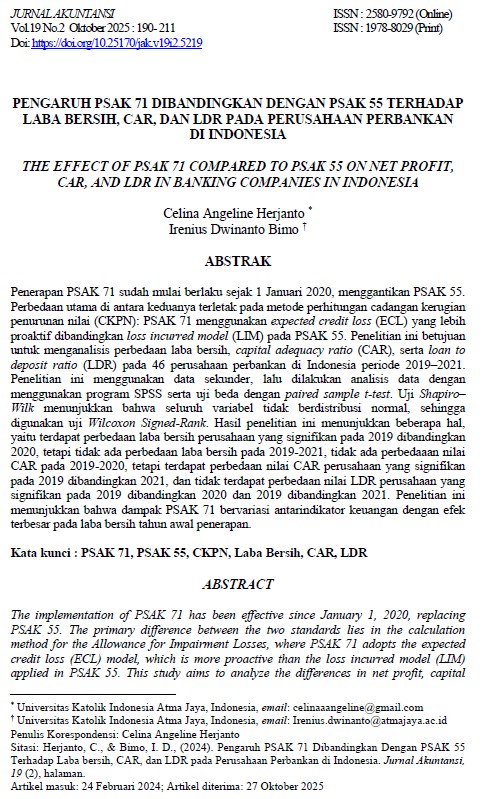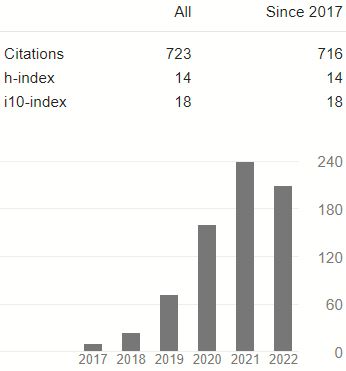THE EFFECT OF PSAK 71 COMPARED TO PSAK 55 ON NET PROFIT, CAR, AND LDR IN BANKING COMPANIES IN INDONESIA
DOI:
https://doi.org/10.25170/jak.v19i2.5219Keywords:
PSAK 71, PSAK 55, CKPN, Laba Bersih, CAR, LDR, Impairment Loss Reserves, Net ProfitAbstract
The implementation of PSAK 71 has been effective since January 1, 2020, replacing PSAK 55. The primary difference between the two standards lies in the calculation method for the Allowance for Impairment Losses, where PSAK 71 adopts the expected credit loss (ECL) model, which is more proactive than the loss incurred model (LIM) applied in PSAK 55. This study aims to analyze the differences in net profit, capital adequacy ratio (CAR), and loan-to-deposit ratio (LDR) in 46 banking companies in Indonesia during the 2019–2021 period. Secondary data were used, and the analysis was conducted using SPSS. While the initial analysis applied the paired sample t-test, the Shapiro–Wilk normality test indicated that all variables were not normally distributed; therefore, the Wilcoxon signed-rank test was employed. The results reveal that net profit differs significantly between 2019 and 2020, but shows no significant difference between 2019 and 2021. CAR does not differ significantly between 2019 and 2020, but differs significantly between 2019 and 2021. LDR shows no significant differences in both year-to-year comparisons. These findings indicate that the impact of PSAK 71 varies across financial indicators, with the strongest effect observed on net profit during its first year of implementation.
References
Abdul, F., & Jalloh, M. (2020). The impact of IFRS 9 adoption on the financial performance of commercial banks in Sierra Leone. International Journal of Accounting and Financial Reporting, 10(2), 170–187. https://doi.org/10.5296/ijafr.v10i2.17573
Bhatia, S. (2020). Impact of implementation of IFRS 9 on capital adequacy ratio: Evidence from Indian banks. Asian Journal of Accounting Research, 5(2), 165–175. https://doi.org/10.1108/AJAR-10-2019-0084
Bischof, J., & Daske, H. (2016). Interpreting the European Union’s IFRS 9 endorsement process: Standard setting, endorsement, and enforcement. Accounting in Europe, 13(2), 129–170.https://doi.org/10.1080/17449480.2016.1210183
Devi, S., Wigarba, I. G. A., Herawati, N. T., & Yasa, N. P. (2021). A Comparison between PSAK 71 and PSAK 55 in the banking industry. Jurnal Ekonomi dan Bisnis, 24(1), 173-188. https://doi.org/10.24914/jeb.v24i1.4382
Ginoga, L. F. & Syahwani, A. K. I. (2022). Analisis dampak NPL, CKPN, LDR, dan suku bunga kredit terhadap penyaluran kredit perbankan pada masa pandemi covid-19. Jurnal Ekonomi Bisnis, 21(1), 49-58. https://doi.org/10.32722/eb.v21i1.4569
Haryono. 2017. Pengaruh kebijakan dividen dan pertumbuhan pendapatan terhadap pertumbuhan laba pada perusahaan manufaktur. Jurnal Ilmiah Akuntansi dan Keuangan, 3, 70–76.
Ikatan Akuntan Indonesia. Standar Akuntansi Keuangan (SAK). Diakses pada tanggal 15 Oktober 2022, dari https://web.iaiglobal.or.id/SAK-IAI/Tentang%20SAK%20Umum#gs c.tab=0
Ikatan Akuntan Indonesia. PSAK 71: Instrumen keuangan. Diakses pada tanggal 15 Oktober 2022, dari https://web.iaiglobal.or.id/Berita-IAI/detail/pengesahan-amendemen-psak-71-amendemen-psak-55-dan-amendemen-psak-60-tentang-reformasi-acuan-suku-bunga#gsc.tab=0
Indonesia. Undang-Undang Nomor 10 Tahun 1998 tentang Perbankan. Jakarta.
Indramawan, D. (2019). Implementasi PSAK 71 pada perbankan. Bankers Update: Buletin Ikatan Bankir Indonesia, 31, Diakses pada 16 Oktober 2022, dari https://ikatanbankir.id/wp-content/uploads/2019/11/Bankers-Update Vol-31-2019-Implementasi-PSAK-71-Pada-Perbankan.pdf
Karyadi, I., & Julindrastuti, D. (2021). Kajian faktor-faktor yang berpengaruh pada kinerja keuangan industri perbankan di Bursa Efek Indonesia. Fakultas Ekonomi dan Bisnis Universitas Wijaya Kusuma Surabaya, 3(1), 133-160.
Kasmir, S. E. (2018). Bank dan lembaga keuangan lainnya (Edisi Revisi). Raja Grafindo Persada.
Ningrum, N.C., Lubis, P.M., & Firmansyah, A. (2022). Cadangan kerugian penurunan nilai piutang perusahaan perbankan sebelum dan sesudah implementasi PSAK 71. Financial and Tax, 2(1), 32-47.
Oktaviani, M. A. & Notobroto, H. B. (2014). Perbandingan tingkat konsistensi normalitas, distribusi metode Kolmogorov-smirnov, Lilliefors, Shapiro-Wilk, dan skewness-kurtosis. Jurnal Biometrika dan Kependudukan, 3(2), 127-135.
PricewaterhouseCoopers. (2019). PSAK 71 – Financial instruments. Diakses pada 16 Oktober 2023, dari https://www.pwc.com/id/en/publications/assurance /psak-ccd-71.pdf
Putri, I. G. A. N. K. & Mustanda, I. K. (2019). Pengaruh kecukupan modal, likuiditas, dan non-performing loan terhadap profitabilitas pada LPD di Kota Denpasar. E-Jurnal Manajemen, 8(6), 3360-3387.
Stice, E. K. & Stice, J. D. (2012). Intermediate financial accounting (18th ed.). South Western.
Sudrajat, D., & Rahayu, S. (2018). Pengaruh capital adequacy ratio (CAR) dan cadangan kerugian penurunan nilai (CKPN) terhadap return on asset (ROA) pada PT. Bank Pembangunan Daerah Jawa Barat dan Banten, Tbk. Journal of Banking & Management Ekuitas, 2(2), 7–13.
Syahid, D. C. N. (2016). Pengaruh faktor eksternal dan internal terhadap kredit bermasalah serta dampaknya terhadap cadangan kerugian penurunan nilai menurut PSAK 55. Jurnal Perbanas, 2(1), 1–23.
Tsalavoutas, I., & Dionysiou, D. (2014). Value relevance of IFRS mandatory disclosure requirements. Journal of Applied Accounting Research, 15(1), 22–42. https://doi.org/10.1108/JAAR-03-2013-0021
Witjaksono, A. (2018). Perbandingan perlakuan akuntansi kredit menurut PSAK 55, PSAK 71, dan basel pada bank umum, Jurnal Online Insan Akuntan, 3(2), 111-120.
Yusdika, A.I., & Purwanti, D. (2021). Implementation of PSAK 71 financial instruments in the banking sector during covid-19 pandemic. Jurnal Aplikasi Ekonomi Akuntansi dan Bisnis, 3(1), 402-416.

Downloads
Published
Issue
Section
License
Copyright (c) 2025 Celina Angeline Herjanto, Irenius Dwinanto Bimo

This work is licensed under a Creative Commons Attribution-ShareAlike 4.0 International License.
Authors who publish with this journal agree to the following terms:
- Authors retain copyright and grant the journal right of first publication with the work simultaneously licensed under a Creative Commons Attribution-ShareAlike 4.0 International License that allows others to share the work with an acknowledgment of the work's authorship and initial publication in this journal.
- Authors are able to enter into separate, additional contractual arrangements for the non-exclusive distribution of the journal's published version of the work (e.g., post it to an institutional repository or publish it in a book), with an acknowledgment of its initial publication in this journal.
- Authors are permitted and encouraged to post their work online (e.g., in institutional repositories or on their website) prior to and during the submission process, as it can lead to productive exchanges, as well as earlier and greater citation of published work.














